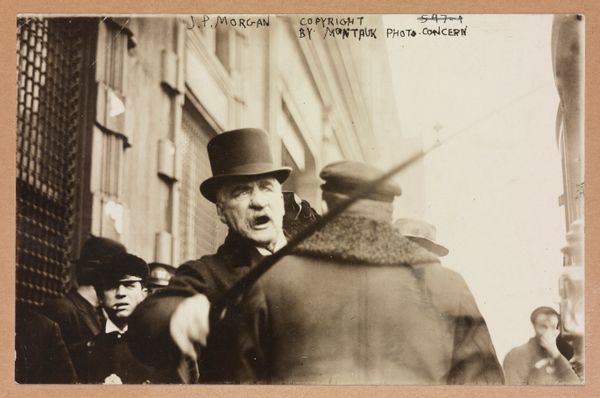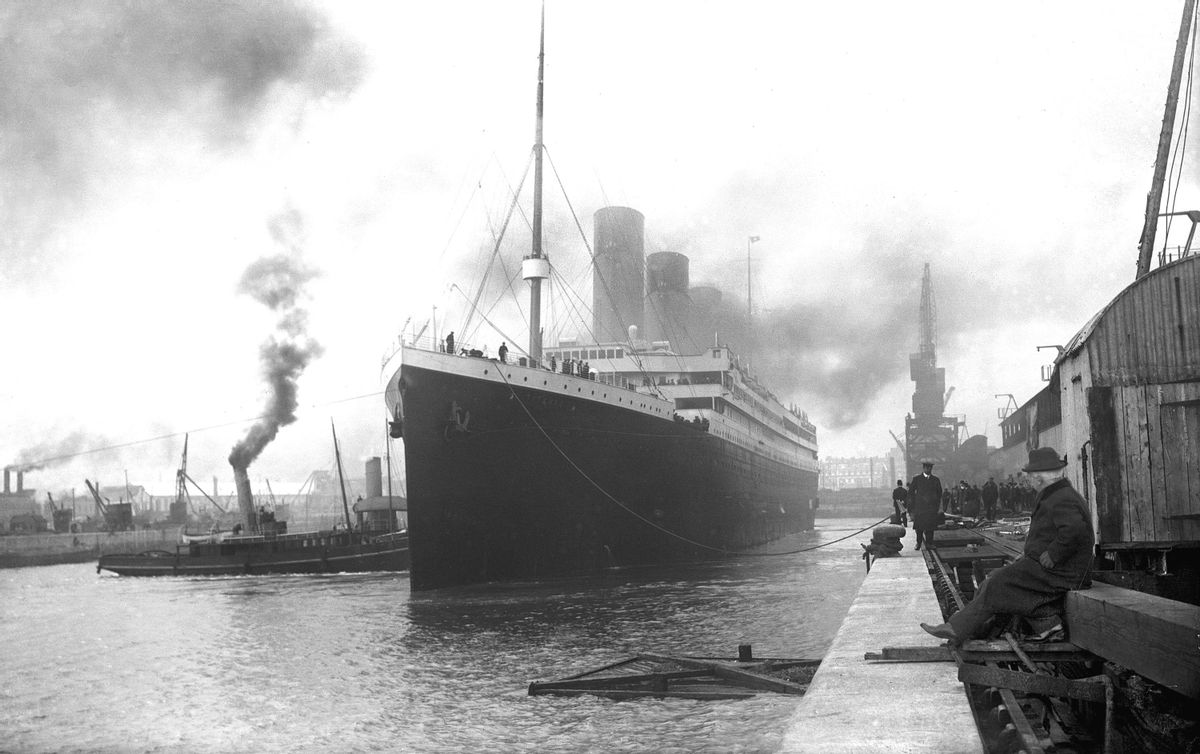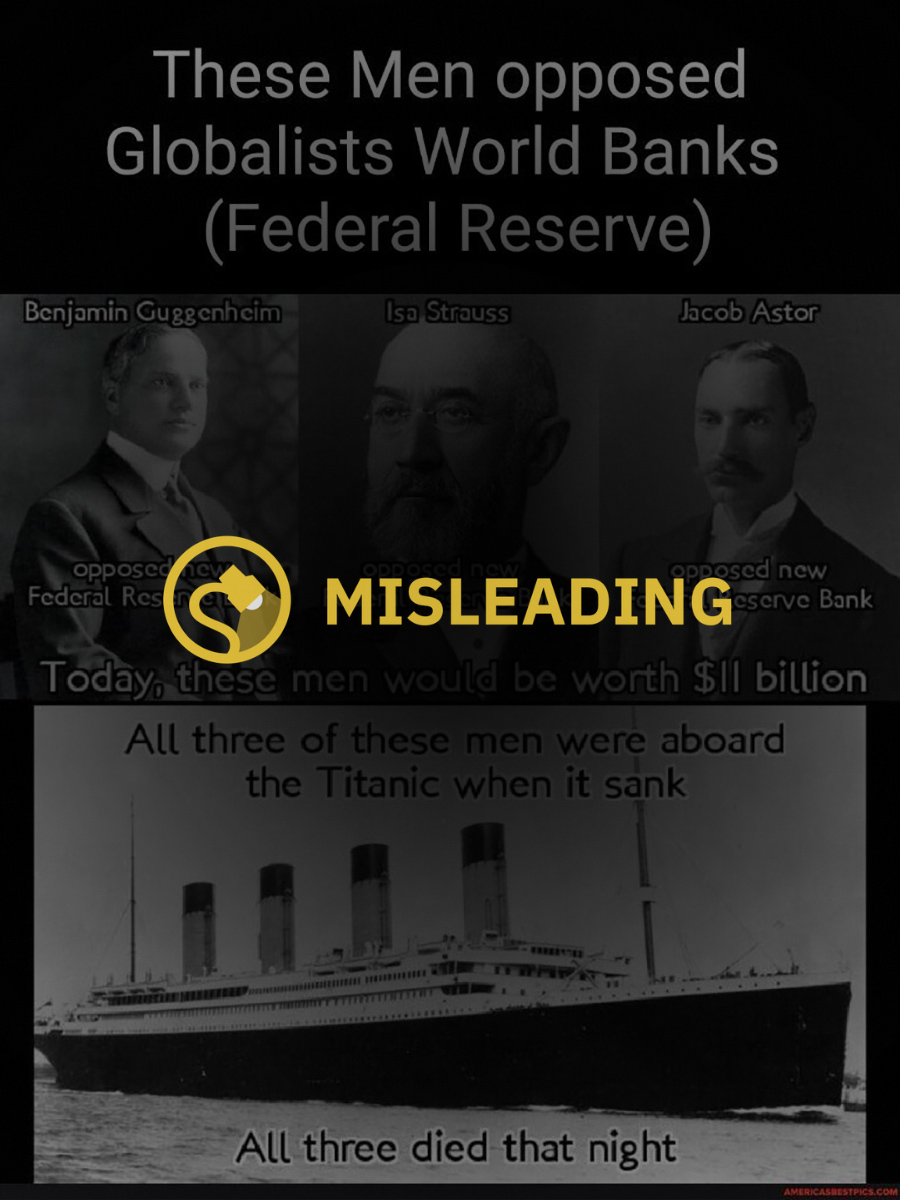On Sept. 13, 2022, a Telegram user shared a baseless meme that hinted the sinking of the Titanic was an inside job. It read, "These men opposed globalist's world banks (Federal Reserve). Benjamin Guggenheim, Isidor Straus, [and John] Jacob Astor [all] opposed the new Federal Reserve bank. Today, these men would be worth $11 billion. All three of these men were aboard the Titanic when it sank. All three died that night."
According to the TinEye reverse image search website, this meme had been shared since at least 2014. However, the rumor itself had started spreading several years before.
A Baseless Conspiracy Theory
It's true that American businessman Benjamin Guggenheim, Macy's co-owner Isidor Straus, and fur magnate and real estate developer John Jacob Astor all perished in the sinking of the Titanic. However, the overall claim intimated by the meme was nothing more than a baseless conspiracy theory.
The misleading meme appears to have been born out of previous ones that mentioned American financier J.P. Morgan. Morgan owned the companies that managed the Titanic and was not a passenger on its maiden voyage.
Past memes suggested that Morgan had somehow miraculously orchestrated the voyage to end in tragedy in order to kill Guggenheim, Straus, and Astor.
 J.P. Morgan striking photographer with cane. (Courtesy: Library of Congress)
J.P. Morgan striking photographer with cane. (Courtesy: Library of Congress)
According to the memes, Morgan's supposed reason for planning the demise of the three prominent men was because they all opposed the formation of the Federal Reserve. (The centralized banking system was established in 1913, the year after the sinking of the Titanic.)
The meme in question also said, "Today, these men would be worth $11 billion." However, it's unclear how much each of the men's descendants would be worth today had they survived.
Titanic Expert George Behe Says 'False'
In March 2021, Reuters published a thorough report that debunked the rumor behind all of the memes on this subject. The article included an interview with a Titanic expert named George Behe, whose research into the history of Titanic goes all the way back to the 1970s. According to Behe, there is no known evidence that showed Guggenheim, Straus, or Astor opposed the formation of the Federal Reserve. In fact, in 1911, The New York Times reported that Astor was very much in favor of the idea.
It's widely agreed upon by experts that the sinking of the Titanic was an accident, the reporting from Reuters said. The ship struck an iceberg on the night of April 14, 1912. Within hours, more than 1,500 people had died.
We contacted Behe in an effort to find out if there had been any updates since Reuters published its story in 2021.
"To the best of my knowledge, the conspiracy theory is just as false today as it was when it was first created, and no important new revelations have turned up within the last couple of years," Behe told us in an email dated Jan. 8, 2023. "Sadly, once these nonsensical conspiracy theories have been foisted upon the general public via the internet, the theories are destined to plague humanity forevermore and will continue to fool innocent people who are unfamiliar with the facts."
Thoughts from Historian J. Kent Layton
For further details, Behe pointed us in the direction of historian J. Kent Layton, who is credited as an author for books including, "Conspiracies at Sea: Titanic and Lusitania," "On a Sea of Glass: The Life & Loss of the RMS Titanic," and "Recreating Titanic & Her Sisters: A Visual History."
"We've been tackling this nonsense with historical data since at least the late-90s to early-00s," Layton told us by email in June 2023. "However, social media is a fantastic breeding ground for conspiracies of all sorts. Titanic seems to be a favorite of many."
Layton remarked to us in detail regarding why the conspiracy theory made no sense to him:
I would point out that if the sinking had actually been a conspiracy to kill those three individuals, there would have been no way that they could ensure their actual demise unless they had locked them somewhere inside the ship to die as it sank. Instead, the evidence indicates that all three were seen during the sinking.
Guggenheim famously case aside his heavy coat and lifebelt after his steward had helped him into them, saying that he and his manservant were 'dressed in their best and prepared to go down as gentlemen'.
Straus nearly made it into a lifeboat, and fellow passengers even recommended that he board a lifeboat with his wife, but he deferred, preferring to let women and children board while he waited behind with other men.
Astor was seen very late in the disaster, helping his wife into a lifeboat; when he asked an officer loading the boat, apparently Second Officer Lightoller, if he could board, Lightoller said no. However, Lightoller had maintained a rather rigid policy of allowing no men into the lifeboats that he filled, and there had been plenty of other opportunities for Astor to board a boat. In fact, we recently discovered an account that indicated that Astor and his wife had approached an early boat on the other side of the ship, when the situation seemed less serious, but that they had stepped back from the lifeboat of their own accord at the last moment and stayed for a while longer on the ship.
If a conspiracy to kill these three men had been so deep and involved so as to actually sink an ocean liner and kill hundreds of innocent people, one would think that the individuals responsible would not have left the survival of these three men to chance.
This story will be updated in the future should we uncover any further helpful information.



